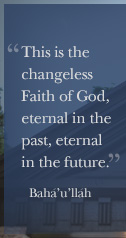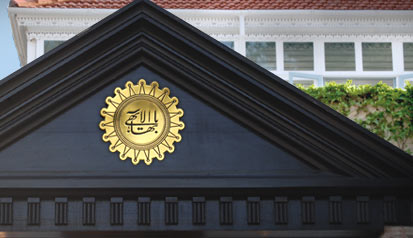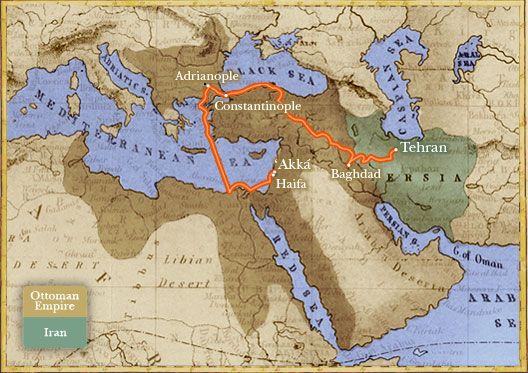The Life of Baha'u'llah
A photographic narrative


Throughout history,
God has revealed Himself to humanity through a series of divine
Messengers, each of whom has founded a great religion. The Messengers
have included Abraham, Krishna, Zoroaster, Moses, Buddha, Jesus, and
Muhammad.
The latest of these Messengers is Bahá’u’lláh, who brings new spiritual and social teachings for our modern age. He taught that there is only one God, that all of the world’s religions are from God, and that now is the time for humanity to recognize its oneness and unite.
 The photographs that follow give a
glimpse into the extraordinary life of Bahá’u’lláh, known to the
worldwide Bahá’í community as the latest “Manifestation of God.” They
present His story in pictures: His birthplace, the cities of His exile, the cell in which He was confined for two years and His final resting place. Here, too, are examples of His handwriting, relics of His remarkable life, and photographs of the beautiful gardens in the Holy Land which His life inspired.
The photographs that follow give a
glimpse into the extraordinary life of Bahá’u’lláh, known to the
worldwide Bahá’í community as the latest “Manifestation of God.” They
present His story in pictures: His birthplace, the cities of His exile, the cell in which He was confined for two years and His final resting place. Here, too, are examples of His handwriting, relics of His remarkable life, and photographs of the beautiful gardens in the Holy Land which His life inspired.
What is not here is a picture of Bahá’u’lláh Himself. For Bahá’ís, the station of Bahá’u’lláh is such that even His photograph is very precious. It should, therefore, only be viewed with the utmost reverence and respect and not displayed openly, even in the private homes of Bahá’ís.
The latest of these Messengers is Bahá’u’lláh, who brings new spiritual and social teachings for our modern age. He taught that there is only one God, that all of the world’s religions are from God, and that now is the time for humanity to recognize its oneness and unite.
What is not here is a picture of Bahá’u’lláh Himself. For Bahá’ís, the station of Bahá’u’lláh is such that even His photograph is very precious. It should, therefore, only be viewed with the utmost reverence and respect and not displayed openly, even in the private homes of Bahá’ís.
Photos: The entrance to the tomb of Bahá’u’lláh. The inscription, an invocation in Arabic meaning “O Glory of Glories,” is a reference to Bahá’u’lláh.
The Life of Baha'u'llah
A photographic narrative
The setting
A photographic narrative
The setting
The life of Bahá’u’lláh and the events associated with the birth
of a new revelation from God unfolded in the 19th century in the Islamic
world of Iran and the Ottoman Empire.
The stern control of those two central powers dictated Bahá’u’lláh’s movements His entire life, starting in what was then called Persia, where He was born.
The stern control of those two central powers dictated Bahá’u’lláh’s movements His entire life, starting in what was then called Persia, where He was born.
Map with overlay depicting the approximate boundaries of Iran and the Ottoman Empire in 1850 and the route of Bahá’u’lláh’s forced exile from His home in Tehran to the prison city of ‘Akká. Map with modern names and borders.
http://www.bahaullah.org/
http://www.bahaullah.org/iran/
http://www.bahaullah.org/constantinople/
http://www.bahaullah.org/constantinople/
http://www.bahaullah.org/adrianople/
http://www.bahaullah.org/akka/
http://www.bahaullah.org/mazraih/
http://www.bahaullah.org/ridvan/
http://www.bahaullah.org/bahji/
http://www.bahaullah.org/haifa/
http://www.bahaullah.org/shrine/
http://www.bahaullah.org/relics/
http://www.bahaullah.org/tablets/
http://www.bahaullah.org/notes/
http://www.bahaullah.org/credits#credit_introduction1

